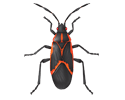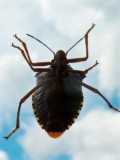Football consumes your Sundays, leaves are changing colors, giving you another yard chore, and your kids are now the school’s responsibility during the day…fall is upon us! While you’re getting swept up in Halloween decorating and transitioning your wardrobe to autumnal colors, you may not realize some visitors are entering your home. We’re not talking about your in-laws dropping by because they were “in the neighborhood,” no, we are talking about over-wintering pests invading your living space.
Temperatures are dropping, and pests use this as an excuse to take advantage of modern heating. Rodents are usually the main offenders, but you may also encounter some other menacing-looking creatures. Today, we cover three insects you may encounter this fall and why you shouldn’t be alarmed by their presence.
Get A Free Quote
Box Elder Bugs
 Box elder bugs are roughly 1.5 inches in length with an oval body shape and a “piercing and sucking” mouthpart. They’re distinguishable by the red strips running across their thorax, especially in their early stages of life. One usually associates red with danger in insects, which is the case for our friend the Black Widow Spider. However, box elder bugs should not be the cause for concern like the hour-glass bearing arachnid.
Box elder bugs are roughly 1.5 inches in length with an oval body shape and a “piercing and sucking” mouthpart. They’re distinguishable by the red strips running across their thorax, especially in their early stages of life. One usually associates red with danger in insects, which is the case for our friend the Black Widow Spider. However, box elder bugs should not be the cause for concern like the hour-glass bearing arachnid.
This type of insect is generally considered a “nuisance” pest, whose only real harm comes in the form of carpet stains. They only seem menacing when they cluster together, as they’re known to do inside homes for warmth. Generally, box elder bugs will gather on the southern side of a building to “sun” their skins. If you do see them assembling in your home, don’t be alarmed. This species will not bite or even reproduce during the overwintering phase. You’ll most likely see them in sunnier areas of your home, such as an attic with exposed lighting. A pest professional will know how to prevent them from coming into the home and handle their removal if they are already there without causing a mess, so consult them before destroying valuable items.
Stink Bugs
 The brown marmorated stink bug, more commonly known as just the “stink bug,” is most known for its destruction of American crops. Towards the end of summer, however, they will begin migrating into homes for shelter and warmth. The stink bug is around an inch in size and has a body that strikingly resembls a shield with a scaled brown exterior. As the name suggests, stink bugs emit a very foul odor when provoked or squished, so you will probably notice their presence before ever spotting them.
The brown marmorated stink bug, more commonly known as just the “stink bug,” is most known for its destruction of American crops. Towards the end of summer, however, they will begin migrating into homes for shelter and warmth. The stink bug is around an inch in size and has a body that strikingly resembls a shield with a scaled brown exterior. As the name suggests, stink bugs emit a very foul odor when provoked or squished, so you will probably notice their presence before ever spotting them.
Much like the box elder bug, these will also crowd around sunnier portions of your house when escaping indoors. However, getting rid of them can be tricky, as they usually will enter your home en masse. One home was reported to have over 26,000 of these insects crawling around! Thus, you may need to consult a professional with concerns over the stink bug, because chances are you won’t be able to get them all with a simple vacuum.
Cluster Flies
You may have a few house flies buzzing around your kitchen occasionally, but those are much different than the cluster fly. Given the name due to their hibernating tendencies, cluster flies will pack together in an enclosed space during the transition to fall. They’re typically bigger than the average house fly and will invade spaces normal house flies won’t, which is why cluster flies are often given the name “attic flies.”
Cluster flies can make their way into the voids behind walls, which is where their spread can be troublesome. Blindly spraying chemicals into this area won’t kill off their spread and may actually cause further problems with rodents and other animals searching for food. Always have a professional investigate the situation if you come across cluster flies in your home. They will be able to determine the best course of action.
Prevention
All of the pests mentioned above can be prevented by simple exclusion methods. Perform a thorough inspection around your home for any faults, such as cracks around windows or openings in screen doors and seal the openings. In addition, a pest control professional can provide an exterior treatment that will prevent overwintering pests from entering your home. By proactively monitoring the home’s exterior, you can further protect its interior.
Contact us about what you should be looking for and what can be done!

